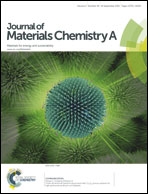A facile one-step hydrothermal synthesis of α-Fe2O3 nanoplates imbedded in graphene networks with high-rate lithium storage and long cycle life†
Abstract
In this study, we demonstrate a facile one-step hydrothermal strategy to build a nanostructure of α-Fe2O3 nanoplates imbedded in graphene networks, using water and glycerol as hydrothermal solvents. The graphene oxide was chemically reduced with Fe2+ and glycerol, and the obtained α-Fe2O3 nanoplates with a thickness of 20–30 nm and a side length of 100–300 nm are well wrapped by and in tight contact with the flexible conductive graphene networks. When used as the anode material for lithium ion batteries, the rGO/α-Fe2O3 nanoplate composite demonstrates high discharge capacities of ∼896 mA h g−1 up to 200 cycles at 5 C and ∼429 mA h g−1 up to 1000 cycles even at a 10 C rate. The excellent lithium storage performance could be attributed to the synergistic effects of the unique structures, which can provide fast electron transport and shorten the diffusion path of the Li ions as well as accommodate the volume change of the composite in the cycling.


 Please wait while we load your content...
Please wait while we load your content...